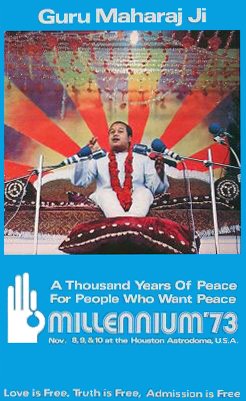
Prem Pal Singh Rawat, formerly known as Maharaji, is an Indian international speaker and author. His teachings include a meditation practice he calls "Knowledge", and peace education based on the discovery of personal resources such as inner strength, choice, appreciation and hope.
Hans Rām Singh Rawat, called Shrī Hans Jī Mahārāj and by various other honorifics, was an Indian religious leader.
The Divine Light Mission was an organization founded in 1960 by guru Hans Ji Maharaj for his following in northern India. During the 1970s, the DLM gained prominence in the West under the leadership of his fourth and youngest son. Some scholars noted the influence of the Bhagavad Gita and the Radha Soami tradition, a.k.a. Sant Mat movement, but the western movement was widely seen as a new religious movement, a cult, a charismatic religious sect or an alternative religion. DLM officials said the movement represented a church rather than a religion.

Rennard Cordon Davis was an American anti-war activist who gained prominence in the 1960s. He was one of the Chicago Seven defendants charged for anti-war demonstrations and large-scale protests at the 1968 Democratic National Convention in Chicago. He had a prominent organizational role in the American anti–Vietnam War protest movement of the 1960s.

A Portapak is a battery-powered, self-contained video tape analog recording system. Introduced to the market in 1967, it could be carried and operated by one person.

Michael Shamberg is an American film producer and former Time–Life correspondent.
Guerrilla television is a term coined in 1971 by Michael Shamberg, one of the founders of the Raindance Foundation; the Raindance Foundation has been one of the counter-culture video collectives that in the 1960s and 1970s extended the role of the underground press to new communication technologies.
This list is of topics related to Prem Rawat (Maharaji).
TVTV was a San Francisco-based video collective that produced documentary video works using guerrilla art techniques.

Who is Guru Maharaj Ji?, published in 1973 by Bantam Books is a non-fiction book about Guru Maharaj Ji, now known as Prem Rawat. Edited by Charles Cameron, the book claims to be an "authentic authorized story", and was written when Maharaj Ji was aged 15. The initial printing was of 125,000 copies. A Spanish-language edition was also published in 1975, as Quién es Guru Maharaj Ji.
The Police Tapes is a 1977 documentary about a New York City police precinct in the South Bronx. The original ran ninety minutes and was produced for public television; a one-hour version later aired on ABC.
Lord of the Universe is a 1974 documentary film on Guru Maharaj Ji.

Millennium '73 was a three-day festival held on November 8–10, 1973 at the Astrodome in Houston, Texas, United States, by the Divine Light Mission (DLM). It featured Prem Rawat, then known as Guru Maharaj Ji, a 15-year-old guru and the leader of a fast-growing new religious movement. Organizers billed the festival as the most significant event in human history which would usher in a thousand years of peace.
Bibliography of Prem Rawat and related organizations lists bibliographical material regarding Prem Rawat and organizations like Divine Light Mission, Elan Vital and the Prem Rawat Foundation.

David R. Loxton, was a British producer of documentaries and other programs for public television in the US.
The Videofreex were a pioneering video collective who used the Sony Portapak for countercultural video projects from 1969 to 1978. They were founded in 1969 by David Cort, Mary Curtis Ratcliff and Parry Teasdale, after Cort and Teasdale met each other at the Woodstock Music Festival. Other early members include Skip Blumberg, Chuck Kennedy, Davidson Gigliotti, Bart Friedman, Carol Vontobel, Nancy Cain, and Ann Woodward, with dozens of additional collaborators participating in the group's cooperative projects.
TV Lab was a program founded at Thirteen/WNET public television station in 1972 by David Loxton with support from the Rockefeller Foundation and New York State Council on the Arts. The program provided artists with advanced video making equipment through an artist-in-residence program. Between 1975 and 1977, the Video Tape Review series was established and broadcast through TV Lab. David Loxton created TV Lab's Independent Documentary Fund in 1977, aiming to provide funding for the creation of independent documentaries. Unable to match funds from the National Endowment for the Arts, the IDF and TV Lab lost support, eventually ending in 1984.
Four More Years is a 1972 documentary covering the 1972 Republican National Convention produced by Top Value Television. The title of the film refers to Richard Nixon's re-election slogan. The convention named Nixon as the Presidential nominee and Spiro Agnew as the nominee for Vice President. All filming takes place on the site of the convention center in Miami Beach, Florida. It was TVTV's second production, after The World's Largest TV Studio (1972), which covered the Democratic Convention one month prior.
Anda Korsts was a Chicago-based video artist and journalist. She was the founder of Videopolis, Chicago's first alternative video space, and worked with TVTV, a national video collective. She was one of the first of many new artists to use the portable camcorder as a tool for art making and radical journalism.
Global Village Video was a pioneering Manhattan-based media center that operated from the late 1960s to the 1980s. It produced and showcased "Guerrilla TV" style video documentaries that featured subject matter and stylistic qualities not seen on mainstream television of the period. Using the battery-operated Sony CV video portapak introduced in 1968, Global Village also trained numerous artists and activists in the new technology, launched the first major video and film festival devoted solely to documentaries, as well as spearheaded a movement to get the work of independent producers on public television.







